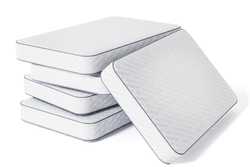How to Store Comforters: A Complete Guide

Our evaluations and opinions are not influenced by our advertising relationships, but we may earn a commission from our partners’ links. This content is created by TIME Stamped, under TIME’s direction and produced in accordance with TIME’s editorial guidelines and overseen by TIME’s editorial staff. Learn more about it.
When it comes to choosing the best comforters are down comforters, there’s nothing quite like snuggling under fluffy, soft, warm bedding to help you achieve a good night’s sleep. Studies support the idea that humans sleep better in a cool environment, though a room that is too “cold” (lower than 60F) could hinder your slumber. If you’re a hot sleeper, the best cooling comforters will provide all the cozy benefits of burrowing into your bed without trapping your body heat.
Comforters are typically filled with down or a down alternative like polyester, cotton, wool, or silk. Occasionally, they’re confused with duvets. When thinking of a duvet vs. a comforter, remember that a duvet is a down filled insert with a removable, washable cover.
Many people choose to store their heavy comforters during hot summer months, switching them out for a lightweight blanket or quilt until the weather cools down again. Storing comforters can be a tricky process due to their fluffy, bulky nature. Down comforters filled with feathers, can be especially daunting as down and feathers can suffer damage if not properly stored. Don’t be discouraged. When armed with the proper knowledge and game plan, you can store a comforter like a pro.
Anytime you store your comforter, or any bedding for that matter, make sure it is both clean and dry. You don’t want to encourage any sort of mold to grow. If you’re unsure how to wash your comforter, first consult the care tag (yes, they’re there for a reason). Unless the tag states otherwise, you can wash and dry your down or down alternative filled comforter at home in a large capacity washer with a mild detergent. Keep in mind that wool and silk filled comforters should be professionally cleaned.
First, spot clean any stains, check for and repair any holes or tears. Use the bulky setting on your washer and select a second rinse cycle if available. Dry on low or no heat and add wool dryer balls to facilitate moving the fill around to avoid clumping. For best results, remove the comforter from the dryer every thirty minutes or so and fluff.
Once clean and dry, fold the comforter and extra bed linens and keep them on uncrowded shelves in a closet. Alternatively, you can also roll a comforter and store it sideways between stacks of sheets and blankets. Once folded or rolled, tie a ribbon around the comforter to keep it together.
Avoid putting anything heavy on top. Just like your down pillows, you don’t want to crush the filling. Whether rolling or folding, try not to pack your shelves too tight. This allows air to flow around the linens, so they can breathe, preventing any mold, as well as mildew and musty smells.
Of course, many people do not have the luxury of a linen closet. Some old houses and apartments , especially, often have a lack of extra storage space.
Finding space in your clothes closet to store a comforter may require some reorganization. Implement a basket or bin system for your shelves. Place your comforter in a bin by itself. Use one that is large enough to allow room for it to “breathe.” Label any baskets or bins, so you’ll be able to easily find what you’re looking for at a future date.
If you have the space, a vintage chest or storage bench offers an excellent receptacle for housing comforters and other bedding. My mom used a cedar chest for this purpose. As well as having a pleasant scent, cedar naturally wicks moisture away, making it ideal for storing blankets and down comforters. You can also use silica packets (or buy cedar chips or blocks to add to a non-cedar chest) to manage moisture.
Store your down comforter under the bed using built-in storage drawers if you have them or simply by placing it in a cotton storage bag to keep dust away. Down alternative comforters can be stored in a vacuum sealed bag to compress their size and make them more manageable. The best places to buy bedding will likely also sell bags, bins, and other storage options.
Avoid storing comforters and other extra bedding in attics or garages where there can be potential rodents. Just like humans, critters love a soft, warm sleeping nest.
Bulky comforters are usually best stored in an extra-large bin or basket. Make sure to choose one with ample room for your comforter to fit without being crushed. If you’re using a plastic bin with a lid, forego the lid if possible, so as not to hinder air flow.
For small spaces, use a cotton storage bag or bin and keep your comforter under your bed. Cotton or polyester filled comforters (no down or feathers) will be just fine in a vacuum sealed bag which means you can compress them down significantly to save space.
In lieu of a dedicated linen closet or under the bed storage, consider a separate, free standing cabinet for bedding storage or even a second dresser. A guest bedroom in your home provides an excellent place for a blanket and sheet designated chest of drawers.
In a closet, store a comforter either using the fold method described below or by rolling it. To roll, fold it in thirds lengthwise, then roll and secure with a ribbon. Don’t stack anything on top and make sure there is space around it to encourage air flow.
The information presented here is created by TIME Stamped and overseen by TIME editorial staff. To learn more, see our About Us page.



